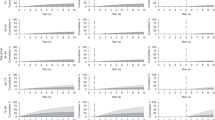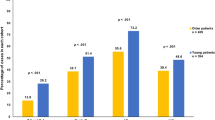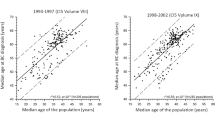Abstract
Following adjuvant therapy for breast cancer, some patients will die of this tumour while the remainder will die of other causes. Deaths from breast cancer tend to follow a lognormal distribution, while deaths from other causes can be approximated by national demographic data. By combining these two survival models, we have generated an age-specific method for estimating the impact of treatment on overall long-term survival. Treatment was designed to operate by one of two mechanisms: an increase in cured fraction, or an increase in median tumour-related survival time among uncured patients. This analysis revealed that, for young and middle-aged patients, an increase in cured fraction has substantially greater long-term clinical impact than an increase in median survival time. Unfortunately, the non-parametric tests traditionally used in prospective clinical trials cannot distinguish between these two mechanisms of action.
This is a preview of subscription content, access via your institution
Access options
Subscribe to this journal
Receive 24 print issues and online access
$259.00 per year
only $10.79 per issue
Buy this article
- Purchase on Springer Link
- Instant access to full article PDF
Prices may be subject to local taxes which are calculated during checkout
Similar content being viewed by others
Author information
Authors and Affiliations
Rights and permissions
About this article
Cite this article
Gamel, J., Vogel, R. A model of long-term survival following adjuvant therapy for stage 2 breast cancer. Br J Cancer 68, 1167–1170 (1993). https://doi.org/10.1038/bjc.1993.498
Issue Date:
DOI: https://doi.org/10.1038/bjc.1993.498
This article is cited by
-
Factors Affecting Distant Disease-Free Survival for Primary Invasive Breast Cancer: Use of a Log-Normal Survival Model
Annals of Surgical Oncology (2000)



